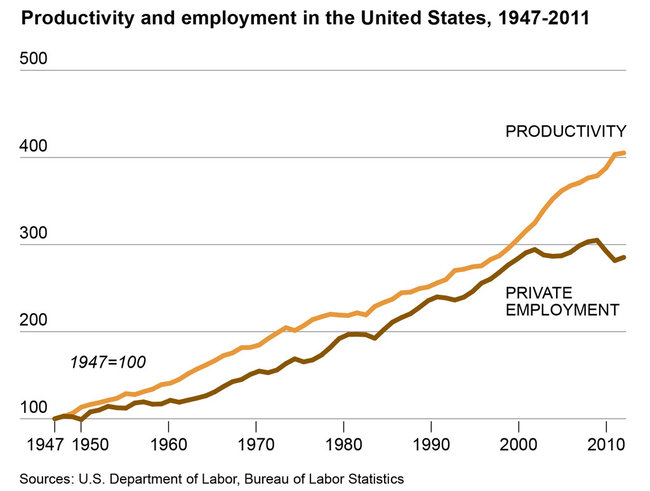
Image from Mother Jones magazine. Artist: Roberto Parada
Worry about machines taking away people’s jobs goes back to at least the 1700s, when the real-life Ned Ludd started smashing “job-stealing” machines and began a movement called Luddism. (Followed by the Captain Swing movement, where farmworkers smashed the farming equipment that did the work they used to do by hand).
Later came the legend of John Henry, who died heroically proving his worth against a machine.
Over the past couple centuries, the world’s economies have transitioned from agriculture to manufacturing as new technologies enabled more work to be done with fewer employees. When America declared its independence from Britain, close to 90% of the population worked in farm-related jobs. Today only about 2% of the population is employed in agriculture, yet food is cheaper than ever before.
Jobs shifted from agriculture to manufacturing as it became more possible to run a farm with fewer farmhands. The American economy was based on manufacturing through most of the 1900s, but manufacturing has been going the same way as agriculture. Mechanization and exportation of labor allowed manufacturing to be done cheaper with machines or foreign workers willing to work for less. Classically American things like Black & Decker tools and Radio Flyer wagons are now made in China.
Manufacturing jobs have moved to countries where labor is cheapest. But countries around the world have been improving their circumstances; developing countries eventually become developed countries. So some manufacturing jobs have moved from China to less-developed countries like Vietnam. Some manufacturing jobs have even moved back to the U.S., but it won’t be enough to restore manufacturing to its former top spot.
Manufacturing has declined in both employment and share of GDP in all but the poorest countries, replaced by the service sector:
But today, even service sector jobs can be automated. A New York Times story on the work of a pair of MIT economists (Erik Brynjolfsson and Andrew McAfee) explores this trend:
During the last recession, the authors write, one in 12 people in sales lost their jobs, for example. And the downturn prompted many businesses to look harder at substituting technology for people, if possible. Since the end of the recession in June 2009, they note, corporate spending on equipment and software has increased by 26 percent, while payrolls have been flat.
Corporations are doing fine. The companies in the Standard & Poor’s 500-stock index are expected to report record profits this year, a total $927 billion, estimates FactSet Research. And the authors point out that corporate profit as a share of the economy is at a 50-year high.
Productivity growth in the last decade, at more than 2.5 percent, they observe, is higher than the 1970s, 1980s and even edges out the 1990s. Still the economy, they write, did not add to its total job count, the first time that has happened over a decade since the Depression.
Productivity and employment levels used to rise together, but not anymore.

A trend called “the jaws of the snake”: Productivity over the past decade has increased while employment levels haven’t.
Brynjolfsson and McAfee recently wrote in the Times:
Adjusted for inflation, the average U.S. household now has lower income than it did in 1997. Wages as a share of G.D.P. are now at an all-time low, even as corporate profits are at an all-time high. The implicit bargain that gave workers a steady share of the productivity gains has unraveled.
What’s going on? Why have job volumes and wages become decoupled from the rest of the train of economic progress? There are several explanations, including tax and policy changes and the effects of globalization and off-shoring. We agree that these matter but want to stress another driver of the “Great Decoupling” — the changing nature of technological progress.
As digital devices like computers and robots get more capable thanks to Moore’s Law (the proposition that the number of transistors on a semiconductor can be inexpensively doubled about every two years), they can do more of the work that people used to do. Digital labor, in short, substitutes for human labor. This happens first with more routine tasks, which is a big part of the reason why less-educated workers have seen their wages fall the most as we moved deeper into the computer age.
As we move ahead the Great Decoupling will only accelerate, for two reasons. First, computers will keep getting cheaper over time. Digital labor will become cheaper than human labor not only in the United States and other rich countries, but also in places like China and India. Off-shoring is only a way station on the road to automation. ….Second, technologies are going to continue to become more powerful, and to acquire more advanced skills and abilities.
We’re now in a third transition like the ones from agriculture to manufacturing and manufacturing to services.

Artist: Roberto Parada
What’s next?


